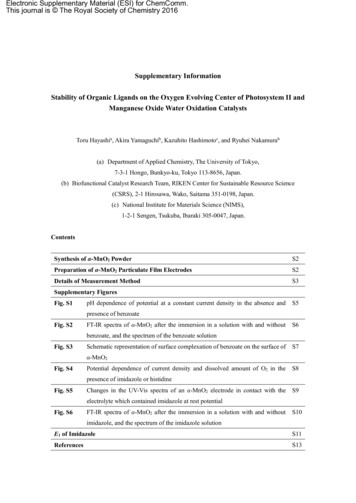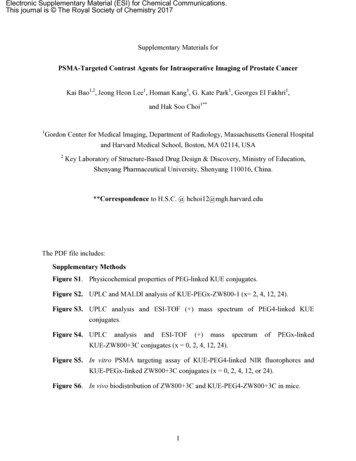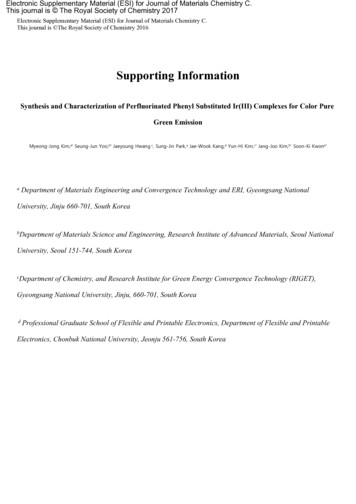
Transcription
Electronic Supplementary Material (ESI) for ChemComm.This journal is The Royal Society of Chemistry 2016Supplementary InformationStability of Organic Ligands on the Oxygen Evolving Center of Photosystem II andManganese Oxide Water Oxidation CatalystsToru Hayashia, Akira Yamaguchib, Kazuhito Hashimotoc, and Ryuhei Nakamurab(a) Department of Applied Chemistry, The University of Tokyo,7-3-1 Hongo, Bunkyo-ku, Tokyo 113-8656, Japan.(b) Biofunctional Catalyst Research Team, RIKEN Center for Sustainable Resource Science(CSRS), 2-1 Hirosawa, Wako, Saitama 351-0198, Japan.(c) National Institute for Materials Science (NIMS),1-2-1 Sengen, Tsukuba, Ibaraki 305-0047, Japan.ContentsSynthesis of α-MnO2 PowderS2Preparation of α-MnO2 Particulate Film ElectrodesS2Details of Measurement MethodS3Supplementary FiguresFig. S1pH dependence of potential at a constant current density in the absence andS5presence of benzoateFig. S2FT-IR spectra of α-MnO2 after the immersion in a solution with and withoutS6benzoate, and the spectrum of the benzoate solutionFig. S3Schematic representation of surface complexation of benzoate on the surface ofS7α-MnO2Fig. S4Potential dependence of current density and dissolved amount of O2 in theS8presence of imidazole or histidineFig. S5Changes in the UV-Vis spectra of an α-MnO2 electrode in contact with theS9electrolyte which contained imidazole at rest potentialFig. S6FT-IR spectra of α-MnO2 after the immersion in a solution with and withoutS10imidazole, and the spectrum of the imidazole solutionE1 of ImidazoleS11ReferencesS13
Synthesis of α-MnO2 Powderα-MnO2 powder was synthesized as previously reported [S1,S2]. 1.10 g of KMnO4 in 20 ml of waterwas stirred for 30 min at 60 oC. Separately, 1.89 g of MnSO4·5H2O in 25 ml of a 2 M acetic acidaqueous solution was stirred for 20 min at room temperature. The solutions were mixed and heatedfor 2 h at 80 oC under a stirred condition. The particles thus obtained were collected, washed, and driedovernight at 60 oC.Preparation of α-MnO2 Particulate Film ElectrodesParticulate film electrodes of α-MnO2 were prepared by a spray deposition method as previouslydescribed [S3]. The amount of deposited α-MnO2 was 0.14 mg cm-2 unless otherwise noted. In thiscase, 75 mg of the α-MnO2 powder was ground in an agate mortar for 5 min, and suspended in 100mL of highly pure Milli-Q water (18 MΩ cm-1) by a sonicator (Q700, QSonica). The suspension wassprayed by a spray gun (ST-6, Fuso Seiki Co., Ltd.) onto a clean conducting fluorine-tin-oxide-coatedglass substrate (SPD Laboratory, Inc.) heated at 200 oC. The electrodes were gently washed with thehighly pure Milli-Q water, and calcined in air for 4 h at 500 oC. The deposited amount was controlledby the initial amount of the α-MnO2 powder.S2
Details of Measurement MethodElectrochemical Measurement in GeneralCurrent density (j) and potential (U) were controlled and measured with a commercial potentiostat andpotential programmer (HZ-5000, Hokuto Denko), using a Pt wire as the counter electrode and aAg/AgCl/KCl (saturated) electrode as the reference electrode. Sodium sulfate was used as thesupporting electrolyte with the concentration set at 0.5 M. Sodium benzoate, imidazole, and guanidinesulfate were used as artificial amino-acid analogs and were introduced by dissolving them into theelectrolyte. The electrolyte solution was prepared using the highly pure Milli-Q water and reagentgrade chemicals, and the pH was adjusted using 1.0 M H2SO4 and 1.0 M NaOH. Guanidine sulfateand isotopic reagents (D2O, and D2SO4 for pD adjustment) were obtained from Sigma-Aldrich, andall other reagents are obtained from Wako and used without further purification.O2 Measurement by a Fluorescence-Based Needle-Type O2 Microsensor (OMS)The concentration of dissolved O2 in the electrolyte solution was monitored using a fluorescencebased needle-type OMS (Microx TX3-trace, PreSens) under stirred condition.Tafel PlotsTafel plots were made by plotting steady-state current at each potential. The electrolyte was filled andstirred by a stir bar at ca. 1000 rpm. The amount of deposited α-MnO2 was decreased to be 0.056 mgcm-2 to lessen the effect of pseudo-capacitance. The highest potential was kept for more than 500 s toavoid the effect of pseudo-capacitance. At other potentials, the steady-state current was measured after90 s. The solution resistance was measured and the resulting ohmic potential loss was corrected.pH Dependence of Potential under a Constant Current ConditionpH dependence of potential under a constant current condition was measured by plotting the potentialduring the change of pH by the addition of NaOH aq. The electrolyte was filled and stirred by a stirbar at ca. 800 rpm. The amount of deposited α-MnO2 was decreased to be 0.056 mg cm-2 to lessenthe effect of pseudo-capacitance. Although ohmic potential loss cannot be corrected because of thechange in the composition of the electrolyte, the change in the solution resistance was so small thatthe slope value was not affected in the experimental accuracy in this time.Kinetic Isotope Effect (KIE) MeasurementKIE was measured based on the ratio of current density during linear sweep voltammetry. Theconcentration of sodium benzoate was 0.5 M, and the scan rate was 10 mV s-1. pD was adjusted basedon the relationship between pD and pH: pD pH 0.4 [S4]. The amount of deposited α-MnO2 was 0.056 mg cm-2. The KIE was calculated at the potentials where the current density reaches 0.25 mAcm-2 in undeuterated electrolyte. The measurement was conducted twice.S3
FT-IR spectroscopyThe structure of bases on the surface of α-MnO2 was analyzed by a Fourier transform infrared (FT-IR)spectrometer (Vertex 70, Bruker). 60 mg of α-MnO2 powder was immersed in 10 mL of the solutionof sodium benzoate or imidazole with 0.1 M deprotonated anions whose pH was adjusted to 7.5 byH2SO4 or NaOH. The solution was stirred for 12 h. The powder was then separated by suction filtrationwith a hydrophilic PTFE membrane filter with a 0.2 μm pore size (JGWP04700, Merck Millipore),followed by vacuum drying in a Schlenk flask. As a control sample, α-MnO2 powder immersed in thehighly pure Milli-Q water was also prepared. After ground in an agate mortar, 20 mg of the driedpowder was pressed by a hydraulic press (SSP-10A, Shimadzu) into a pellet with a diameter of 12 mmfor the measurement.Inlet Electrochemical Mass Spectroscopy (EC-MS)EC-MS was also performed to measure the onset potentials of O2 and CO2 evolution. The principle ofthe EC-MS system was the same as previously reported [S5,S6]. A stainless capillary connected a gastight electrochemical chamber and a quadrupole mass spectrometer (QMG 220 M1, Pfeiffer Vacuum).The end of the capillary in the electrochemical chamber was covered with a microporouspolytetrafluoroethylene (PTFE) membrane (Poreflon WP-010-80, Sumitomo Electric Fine Polymer).Before measuring the evolution of O2 or CO2, the electrochemical chambers were bubbled with argonfor 30 minutes.In-situ UV-vis SpectroscopyOptical absorption of electrodes in contact with the electrolyte was measured by a UV-vis spectrometer(UV-2550, Shimadzu) equipped with a multipurpose large-sample compartment with a built-inintegrating sphere (MPC-2200, Shimadzu), by placing electrodes in front of the integrating sphere andcollecting diffused transmission light. The amount of deposited α-MnO2 was decreased to be 0.056mg cm-2 to lessen the original absorption by the catalyst.S4
Supplementary Figures and Table1.38E / V vs. SHE1.361.34w/o-1.14 mV pH-11.321.301.28w/-15.0 mV pH-11.261.246.57.07.58.0pHFig. S1pH dependence of potential at a constant current density (50 μA cm-2) in the absence andpresence of 50 mM of benzoate.S5
1594154313891179107110261397163515951540(b) as(COO )(c)0.2- s(COO ) (C-H)102610741179 (C-H) (C-Cring)1634Absorbance(a)0.02 (H-O-H)0.2180015001200Wavenumber / cm-1900Fig. S2 FT-IR spectra of (a) α-MnO2 after the immersion in the solution of 0.1 M deprotonatedbenzoate at pH 7.5 adjusted by NaOH for 12 h, (b) the solution of 0.1 M deprotonated benzoate at pH7.5 adjusted by NaOH, and (c) α-MnO2. In (b), the observed peaks at 1388 cm-1 and 1541 cm-1 can beassigned to the symmetric and asymmetric stretching mode of COO- (νs(COO-) and νas(COO-)),respectively [S7,S8]. The peak at 1594 cm-1 can be assigned to the stretching mode of C-C (aromaticring) (ν(C-Cring)) [S7,S8]. The small peak at 1179 cm-1 was assigned to a C-H stretching mode, andthose at 1071 cm-1 and 1026 cm-1 were assigned to C-H in-plane bending modes [S9]. In (a), the bandof νs(COO-) shifted to higher frequency region, which indicated the chemisorption of benzoate on thesurface of α-MnO2 [S7]. The small shift (8 cm-1), as well as broadening of the bands of νs(COO-) andνas(COO-), is in favor of the formation of outer-sphere complexes [S7]. On the other hand, the positionsof the bands from the aromatic ring was almost constant. Those results indicate that benzoate formedouter-sphere complexes with the surfaces of α-MnO2, as shown in Fig. S3, which is a suitableconformation for the induction of CPET.S6
O H2OMn-O H2OMnFig. S3 Schematic representation of surface complexation of benzoate on the surface of α-MnO2 [S7].S7
3.0i / mA cm-22.52.0w/ Imidazolew/ Histidinew/o Bases1.51.00.5Dissolved O2 / ppm0.01.00.80.60.40.20.00.60.81.01.21.41.6E / V vs. SHEFig. S4Potential dependence of current density and dissolved amount of O2 in the presence ofimidazole or histidine (pH 7.5, Scan rate: 1 mV s-1, Concentration of deprotonated imidazole ring: 50mM).S8
0.005 Abs0.000-0.0055 min10 min15 min20 min-0.010Every 40 min3h-0.015300400500600700800900Wavelength / nmFig. S5 Changes in the UV-Vis spectra of an α-MnO2 electrode in contact with the electrolyte whichcontained 500 mM deprotonated imidazole (pH 7.5) at rest potential. The spectrum immediately afterthe contact with the electrolyte was used as a reference.S9
orbance1585(a)0.2180015001200Wavenumber / cm-1900Fig. S6 FT-IR spectra of (a) α-MnO2 after the immersion in the solution of 0.1 M deprotonatedimidazole at pH 7.5 adjusted by H2SO4 for 12 h, (b) the solution of 0.1 M deprotonated imidazole atpH 7.5 adjusted by H2SO4, and (c) α-MnO2. The number of peaks increased after the interaction withα-MnO2, compared to the spectra of the imidazole solution. We regard the new peaks can be assignedto the oxidation products. The derivatives of urea or nitronate were shown as oxidation products ofimidazolyl groups in the previous studies [S10-12], which can be the candidates of the products in ourcases.S10
E1 of ImidazoleEquilibrium between Differently Protonated States of Imidazole and Imidazole RadicalsFirst, the equilibrium between differently protonated states of imidazole and imidazole radicals aresummarized in Scheme S1.Ka1ImH Im - eKr1Ka2Im(-H)-Im Im(-H) Scheme S1 Protonation equilibrium of imidazole and imidazole radicals.ImH 2 , the protonated form of Im , is thermodynamically unstable and deprotonates, thus virtuallydoes not exist. Equilibrium constants are given by following equations:[Im(-H)- ][H ][Im(-H) ][H ]Ka1 , Ka2 , Kr1 [Im][ImH ][Im ][Im][H ]pKa1 7.05 and pKa2 14.5 [S13]; pKr1 has not been reported to our knowledge.Conversion of Vertical Ionization Energy (VIE) to E1As mentioned in the main text, experimental values of the redox potential of the one-electron oxidation(E1) of imidazole has not been reported so far to our knowledge. However, an experimental value ofthe vertical ionization energy (VIE) of imidazole has been reported by a study using photoelectronspectroscopy of liquid microjet [S14]. Thus, the standard E1 (E10(Im /Im)) can be obtained bysubtracting outer-sphere reorganization energy (λ) from VIE.According to the report, the VIE of neutral imidazole (Im) is 3.98 V vs. SHE [S14]. Here, VIE vs.SHE was calculated by using the reported potential of SHE vs. vacuum, 4.28 V [S15, S16]. λ isestimated to be smaller than 1 eV as for the reactions on electrodes in water with the diameter of thereactant larger than 2 Å [S17]. Thus, E10(Im /Im) can be estimated to be more positive than 2.98 Vvs. SHE.S11
pH dependenceAnalysis of the pH dependence of E1 requires consideration of the protonation equilibrium and can beestimated by reference to the method reported by Schroeder et al.[S18]Here, [Im]total and [Im ]total are defined as follows:[H ]Ka2[Im]total [ImH ] [Im] [Im(-H)- ] [Im] ( 1 )Ka1[H ][Im ]total [Im ] [Im(-H) ] [Im ] (1 Kr1)[H ]Thus,[Im] [Im]total Ka1[H ]2[H ] Ka1 [H ] Ka1 Ka2[Im ] [Im ]total [H ][H ] Kr1Thus, a Nernst equation for E1 can be written as follows:2RT[Im ]RT1 [H ] Ka1[H ] Ka1 Ka2E1 E1 (Im /Im) ln () E1 0 (Im /Im) ln ( )F[Im]FKa1[H ] Kr10 Note that [Im]total equals to [Im ]total at E1. By substitution of the pK values, E1 at the standard conditionat pH 7.5 can be calculated as follows:E1 / V vs. SHE E10(Im /Im) / V vs. SHE – 0.4359 – 0.05916 log10(10-7.5 Kr1)Here, E10(Im /Im) corresponds to the E1 estimated from the VIE. Therefore, for E1 to be more negativethan Eonset (@ 75 μA cm-2) in the presence of imidazole at pH 7.5, even when λ 1 eV, pKr1 have tobe less than -27.6. pKr1 has not been reported to our knowledge, but considering that the correspondingpK value of histidine is 5-7 [S19], we can safely estimate that pKr1 is larger than -27.6. Thus, Eonset (@75 μA cm-2) (Fig. 4) can be estimated to be well more negative than E1.S12
References[S1]R. M. McKenzie, The synthesis of birnessite, cryptomelane, and some other oxides andhydroxides of manganese. Mineral. Mag., 1971, 38, 493-502.[S2]M. Singh, D. N. Thanh, P. Ulbrich, N. Strnadová and F. Štĕpánek, Synthesis, characterizationand study of arsenate adsorption from aqueous solution by α- and δ-phase manganese dioxidenanoadsorbents. J. Solid State Chem., 2010, 183, 2979–2986.[S3]A. Yamaguchi, R. Inuzuka, T. Takashima, T. Hayashi, K. Hashimoto and R. Nakamura,Regulating proton-coupled electron transfer for efficient water splitting by manganese oxidesat neutral pH. Nat. Commun., 2014, 5, 4256.[S4]A. K. Covington, M. Paabo, R. A. Robinson and R. G. Bates, Use of the glass electrode indeuterium oxide and the relation between the standardized pD (paD) scale and the operationalpH in heavy water. Anal. Chem., 1968, 40, 700–706.[S5]K. Kamiya, K. Hashimoto and S. Nakanishi, Graphene defects as active catalytic sites that aresuperior to platinum catalysts in electrochemical nitrate reduction. ChemElectroChem, 2014,1, 858-862.[S6]A. H. Wonders, T. H. M. Housmans, V. Rosca and M. T. M. Koper, On-line mass spectrometrysystem for measurements at single-crystal electrodes in hanging meniscus configuration. J.Appl. Electrochem., 2006, 36, 1215-1221.[S7]K. D. Dobson and A. J. McQuillan, In situ infrared spectroscopic analysis of the adsorption ofaromatic carboxylic acids to TiO2, ZrO2, Al2O3, and Ta2O5 from aqueous solutions.Spectrochim. Acta, Part A, 2000, 56, 557-565.[S8]M. R. Das and S. Mahiuddin, Kinetics and adsorption behaviour of benzoate and phthalate atthe α-alumina–water interface: Influence of functionality. Colloids Surf., A, 2005, 264, 90-100.[S9]S. Tunesi and M. A. Anderson, Surface effects in photochemistry: an in situ cylindrical internalreflection-Fourier transform infrared investigation of the effect of ring substituents onchemisorption onto titania ceramic membranes. Langmuir, 1992, 8, 487-495.[S10] K. Uchida and S. Kawakishi, Selective oxidation of imidazole ring in histidine residues by theascorbic acid – copper ion system. Biochem. Biophys. Res. Commun., 1986, 138, 659-665.[S11] K. Uchida and S. Kawakishi, Ascorbate-mediated specific oxidation of the imidazole ring in ahistidine derivative. Bioinorg. Chem., 1989, 17, 330-343.[S12] X. Xing, X. Zhu, H. Li, Y. Jiang and J. Ni, Electrochemical oxidation of nitrogen-heterocycliccompounds at boron-doped diamond electrode. Chemosphere, 2012, 86, 368-375.[S13] H. Walba and R. W. Isensee, Acidity constants of some arylimidazoles and their cations. J. Org.Chem., 1961, 26, 2789–2791.S13
[S14] B. Jagoda-Cwiklik, P. Slavíček, L. Cwiklik, D. Nolting, B. Winter and P. Jungwirth, Ionizationof imidazole in the gas phase, microhydrated environments, and in aqueous solution. J. Phys.Chem. A, 2008, 112, 3499-3505.[S15] C. P. Kelly, C. J. Cramer and D. G. Truhlar, Aqueous solvation free energies of ions and ionwater clusters based on an accurate value for the absolute aqueous solvation free energy of theproton. J. Phys. Chem. B, 2006, 110, 16066-16081.[S16] A. A. Isse and A. Gennaro, Absolute potential of the standard hydrogen electrode and theproblem of interconversion of potentials in different solvents. J. Phys. Chem. B, 2010, 114,7894-7899.[S17] G. J. Kavarmos, Fundamentals of photoinduced electron transfer. VCH, Weinheim, New York,1993.[S18] C. A. Schroeder, E. Pluhařová, R. Seidel, W. P. Schroeder, M. Faubel, P. Slavíček, B.Winter, P.Jungwirth and S. E. Bradforth, Oxidation half-reaction of aqueous nucleosides and nucleotidesvia photoelectron spectroscopy augmented by ab initio calculations. J. Am. Chem. Soc., 2015,137, 201-209.[S19] S. Navaratnam and B. J. Parsons, Reduction potential of histidine free radicals: A pulseradiolysis study. J. Chem. Soc., Faraday Trans., 1998, 94, 2577-2581.S14
S6 Fig. S2 FT-IR spectra of (a) α-MnO2 after the immersion in the solution of 0.1 M deprotonated benzoate at pH 7.5 adjusted by NaOH for 12 h, (b) the solution of 0.1 M deprotonated benzoate at pH 7.5 adjusted by NaOH, and (c) α-MnO2.In (b), the observed peaks at 1388 cm-1 and 1541 cm-1 can be assigned to the symmetric and asymmetric stretching mode of COO-(νs(COO-) and νas(COO-)),

![Ç & µ o Ç o ] v & ] v v - Florida International University](/img/34/2020-2021-ems-calendar3.jpg)








